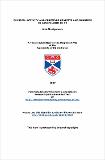Files in this item
Physical activity and perceived benefits and barriers in adults aged 55-74
Item metadata
| dc.contributor.advisor | Farrally, Martin | |
| dc.contributor.author | Montgomery, Alan A. | |
| dc.coverage.spatial | 210 | en_US |
| dc.date.accessioned | 2012-06-06T09:48:25Z | |
| dc.date.available | 2012-06-06T09:48:25Z | |
| dc.date.issued | 1997 | |
| dc.identifier.uri | https://hdl.handle.net/10023/2663 | |
| dc.description.abstract | In order to increase the number of older adults physically active enough to obtain the health benefits of exercise, inactive individuals must firstly be identified, and attention must then be focused on determinants of exercise amenable to change. This study set out to develop self-complete questionnaires for assessing activity status, and perceived benefits of, and barriers to, physical activity. Of 1456 questionnaires sent out to a random sample of adults aged 55-74 a usable return rate of 37.6% (n=548) was achieved. A principal components analysis of the benefits of physical activity revealed five factors (physical performance, social, weight control, enjoyment, and psychological), and of the barriers to physical activity, also five factors (opportunities, physical exertion, time, limiting health, and support). Alpha internal consistency coefficients for the 10 factors ranged from 0.64 to 0.92, and test-retest reliability coefficients from 0.56 to 0.87. A series of one-way ANOVAs revealed that, with the exception of the benefit weight control, there was a significant gradation in factor scores between active and inactive subjects as classified by 4-, 9-, and 5- point activity classification methods. Validity of the activity classifications was assessed in a subsample of 86 subjects against measures of strength, flexibility, aerobic fitness and objectively measured physical activity. Active and inactive subjects classified using the 4- and 9-point questionnaires differed significantly in 1-mile walk time and energy expenditure estimated by a Caltrac accelerometer. The 5-point questionnaire did not appear able to differentiate active and inactive subjects. Test-retest reliability of the questionnaires ranged from 0.62 to 0.73. The questionnaire developed from this work for measuring perceived benefits and barriers of older adults can be used in either practical or research settings. Further work is required to determine the accuracy of the physical activity questionnaires in identifying low-active individuals in the population. | en_US |
| dc.language.iso | en | en_US |
| dc.publisher | University of St Andrews | |
| dc.subject.lcc | RA777.6M7 | |
| dc.subject.lcsh | Older people--Health and hygiene | en_US |
| dc.subject.lcsh | Aging | en_US |
| dc.subject.lcsh | Aging--Prevention | en_US |
| dc.title | Physical activity and perceived benefits and barriers in adults aged 55-74 | en_US |
| dc.type | Thesis | en_US |
| dc.type.qualificationlevel | Doctoral | en_US |
| dc.type.qualificationname | PhD Doctor of Philosophy | en_US |
| dc.publisher.institution | The University of St Andrews | en_US |
This item appears in the following Collection(s)
Items in the St Andrews Research Repository are protected by copyright, with all rights reserved, unless otherwise indicated.

